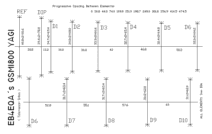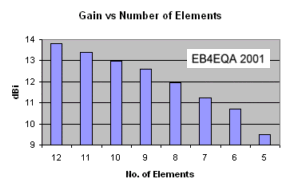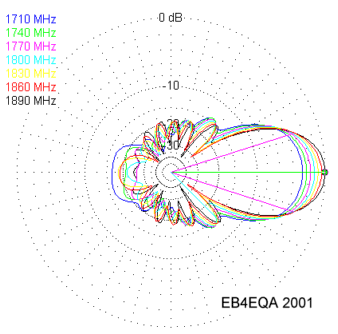If you are looking for a high-gain antenna to extend the range of your GSM1800 band cellular telephone, you've come to the right place. This antenna works dramatically better than the small tip found in most cell-phones and lets you use the phone where it was not possible before. There is only one "but" with it: it's very, very directional, and you'll have to play a bit until you find the right direction to point to. If the available signal in your location is very weak, aiming could get very critical, and you'll have to spend some time to aim the antenna.
Also, you must know that the time slot between packets in the GSM system, does not allow a phone to connect to a site that is more than about 40km appart, no matter how strong the signal at both sides of the RF path is. This antenna could be useful where mountains, buildings or anything gets in the almost line-of-sight way to the cell phone site, and of course, there is still some signal available (we still can't model miracles in software...)
THE ANTENNA:
The antenna consists of 1,5mm diameter copper wire pieces. It is a classic yagi design by DL6WU, with a reflector, 10 directors and a split dipole (not a folded one!) as excited element. The elements are so small and lightweight that they can be glued to a small plastic or wood boom (anything but a conductive material). Here is the construction plan for the antenna for download. If you print it to scale you can trim the lenght of the elements and build the antenna directly on the surface of the paper:

Why a split instead of a folded dipole? Now, that's a good question. I've experimented, read and studied the subject and finally decided to use a split dipole. These are the reasons I've found:
- If I feed the model antenna in software with a split dipole, just to simulate how it would work in real world, with good results, why should I then use any other thing than a split dipole for feeding the real antenna?
- I may get some losses because the split dipole does not have a 50 ohm feed point impedance, and it is balanced while the coax is unbalanced. But, I more than probably will get much greater losses in the balun and folded dipole, both difficult to build and impossible to model on today's software.
- As in any other thing in life, if I have two choices, none of them clearly better than the other, but one much more simple to get, which one will I take? Yes, the easy one (and that is the split dipole).
The expected SWR and radiation pattern for the GSM1800 band yagi are these:
|
|
You can see in the plot that the SWR does not get any higher than 1,5:1 on the entire GSM 1800 band. As you should have little attenuation in the coax, that wouldn't be of much importance, but that way the phone won't lower the RF power on transmit. I've divided the band in three zones: the red zone (1710-1785Mhz) is where the cell-phone transmits and the blue one (1805-1880Mhz) is where the phone receives. The radiation diagram shows how the pattern changes across the band. The gain found in the main lobe is always around 12dBi.
THE FEEDLINE:
You must be very careful when choosing the coax. This frequencies are so high that you could get an enormous attenuation even with reasonable lengths of cable. If you use thin RG-174, don't use more than one meter. With RG58 you could use a few more, but not many. Any cable thicker than that does not seem very practical to be connected to a cellular phone. It is also advisable to keep connectors away, but if you need to use them, use only N, SMA or BNC types. Never, never use a PL-259.
The way you connect the cable to the phone is something you'll have to think by yourself. You could use the small antenna connector that most phones have, or you could just (as I've done) savage an old phone and connect the coax directly to the RF PCB in the phone. This way, you can skip the connector and other circuitry found at the antenna input, to keep the losses as low as possible.
To transmit, the cell-phone sites use panels with crossed polarization. That means that the orientation (vertical or horizontal) of your antenna should not make any difference in the strength of the signal. I've written "should" because I've noticed big changes in signal strenght when turning the antenna.
VARIATIONS:
You may think that this antenna is too large (or too directive) for your particular purposes. You may wonder if it's possible to just take out some of the elements to get a smaller antenna, knowing that the available gain will still be enough for you. The answer is, although for best results everything should be re-designed each time you make such a modification, yes. Of course, the radiation pattern will be far from optimal, as any other parameter of the antenna. But the truth is, that you could take out as much as 4 elements without getting a SWR too high and the gain will still be respectable. Just take a look at this results of the software analysis:

If you need an antenna for any other frequency or band, remember that if you rescale EVERY dimension (including element diameter) in this design, you'll get the same results.

